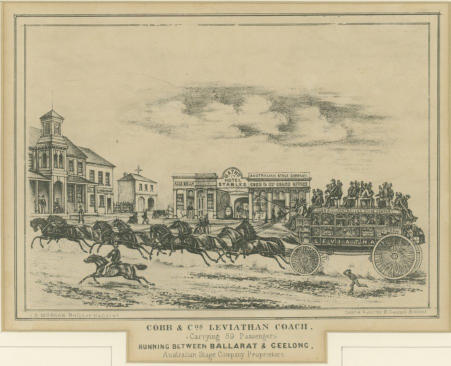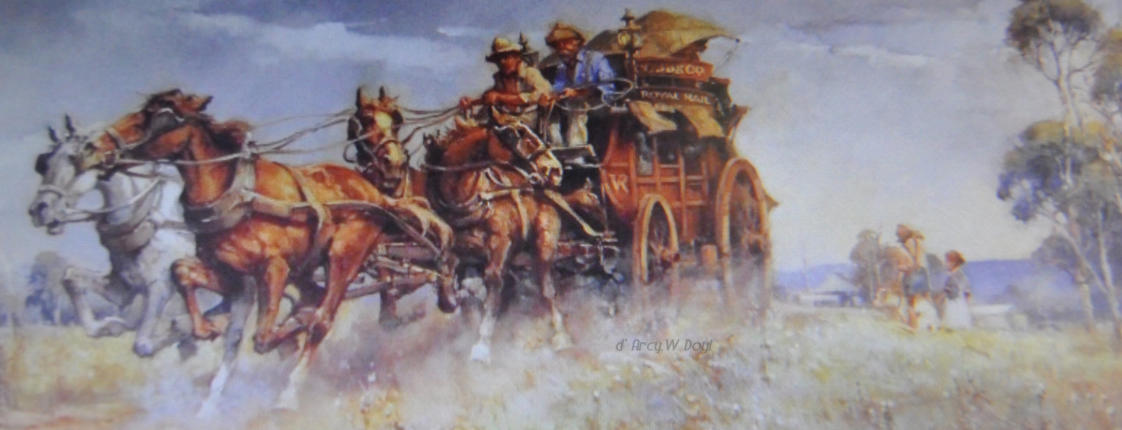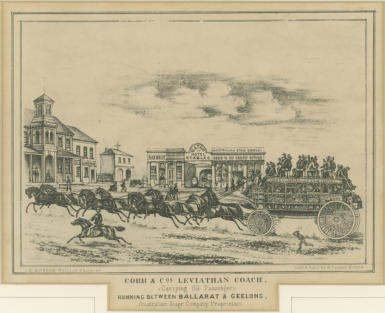
HEADING TEXT
Incredible
as
it
may
seem
these
coaches
were
licensed
to
carry
17
people
and
the
service
throughout
Australia
was
extremely
well
used.
Cobb
&
Co.'s
among
the
innovations
included
using
experienced
American
coach
drivers,
many
of
whom
had
driven
stagecoaches
in
the
west.
Later
they
also
bred
their
own
horses
which
were
suited
to
the
task
of
pulling
a
fully
laden
coach
at
a
gallop.
From
the
beginning,
they
also
ensured
that
each
trip
was
divided
up
into
sections
of
around
10
to
30
miles
so
horses
could
travel
quickly
and
then
be
swapped
for
a
fresh
team.
This
was
perhaps
one
of
the
most
important steps taken by the new company of Cobb & Co. as it meant a faster trip for passengers and a relatively more comfortable ride.
Staging
posts
were
set
up
along
each
route
where
teams
of
horses
were
swapped
and
tired
horses
stabled,
rested
and
fed.
As
a
coach
approached
the
changing
station
the
driver
sounded
a
horn
or
bugle
to
let
the
groom
know
the
coach
was
arriving.
Every
driver
had
his
own
call,
so
the
groom
knew
which
team of horses to have ready. This system meant that changeovers could occur as quickly as possible and the coach could continue on its way.
The
visitor
the
the
Australian
Teamsters
Hall
Of
Fame
can
visit
one
these
staging
posts
opposite
the
museum
that
has
been
full
renovated
and
the
museum oposite is located on the original land that the holding yards and stables stood.
Whilst
the
Teamsters
and
indigenous
population
all
played
their
part
in
opening
up
Australia,
Cobb
and
Co.
got
the
settlers,
gold
miners
and
business
people around Australia. But … the 17 seater’s were not enough for them, they wanted to up size and so they came up with the ‘Leviathan’.

An interview with Steve on local Television showing the scale of the project
he is involved in. He is a bushy, he is extremely skilled

Darcy Doyle’s famous painting
Cobb & Co.

The Leviathan.
Cobb and Co. catered to the demand for their service by building bigger, The
Leviathan Coach was able to carry 89 passengers and required an eight horse team
to haul the massive coach around the Eastern States.
There are very few examples of the Leviathan coach surviving today today, but
Steve is in the process of building an authentic replica utilising copies of original
plans. It is a labour of love and extremely hard work. Steve has no outside funding,
government of private, so this truly is a labour of love.
See the interview below.

The Spirit Of Cobb & Co.
Cobb and Co.
The
original
company
was
established
in
Melbourne
in
1853
at
the
height
of
the
excitement
created
by
the
Victorian
goldrushes,
by
four
newly
arrived
North
Americans
-
Freeman
Cobb,
John
Murray
Peck,
James
Swanton
and
John
B.
Lamber.
Initially
the
company
traded
as
the
"American
Telegraph
Line
of
Coaches,"
a
name
that
emphasized
speed
and
progressiveness.
With
financial
support
from
another
newly
arrived
US
businessman
George
Train,
they
arranged
the
importation
of
several
US-
built
wagons
and
Concord
coaches.
By
early
1854,
the
Company
operated
a
daily
service
to
Forest
Creek
and
Bendigo,
and
soon
afterwards,
expanding
the
service
to
Geelong and Ballarat other goldfields.
In
common
with
many
operatives,
Cobb
&
Co's
horses
were
changed
every
10–15
miles
along
a
stagecoach
"line",
often
at
inns
or
hotels
that
could
also
cater
for
the
needs
of
drivers
and
passengers.
As
Historian
Susan
Priestley
notes,
"Coach
lines
did
not
attempt
to
compete
with...
railways.
Instead,
as
rail
lines
extended,
coaches
were
transferred to feeder routes and were timetabled to link in with trains.
Within
a
few
years,
Cobb
&
Co
had
established
a
reputation
for
efficiency,
speed
and
reliability,
although
they
had
not
won
any
of
the
lucrative
mail
contracts.
Their
imported
coaches
used
thorough-brace
technology
whereby
thick
straps
of
leather
provided
suspension
to
the
body
of
the
vehicle,
thus
providing
the
passenger
with
considerable
comfort
on
the
rough
roads
to
the
goldfields,
by
comparison
to
coaches
with
traditional
steel-springs.
The
Australian
Teamsters
Hall
Of
Fame,
among
it’s
many
exhibits
has
an
original
Cobb
and Co. coach fully restored for visitors to view and to learn about.
Owner and world record holder Steve Ralph will entertain you with tales of Cobb & Co.
The Spirit Of Cobb & Co.
Cobb and Co.
The
original
company
was
established
in
Melbourne
in
1853
at
the
height
of
the
excitement
created
by
the
Victorian
goldrushes,
by
four
newly
arrived
North
Americans
-
Freeman
Cobb,
John
Murray
Peck,
James
Swanton
and
John
B.
Lamber.
Initially
the
company
traded
as
the
"American
Telegraph
Line
of
Coaches,"
a
name
that
emphasized
speed
and
progressiveness.
With
financial
support
from
another
newly
arrived
US
businessman
George
Train,
they
arranged
the
importation
of
several
US-built
wagons
and
Concord
coaches.
By
early
1854,
the
Company
operated
a
daily
service
to
Forest
Creek
and
Bendigo,
and
soon
afterwards,
expanding
the
service
to
Geelong and Ballarat other goldfields.
In
common
with
many
operatives,
Cobb
&
Co's
horses
were
changed
every
10–15
miles
along
a
stagecoach
"line",
often
at
inns
or
hotels
that
could
also
cater
for
the
needs
of
drivers
and
passengers.
As
Historian
Susan
Priestley
notes,
"Coach
lines
did
not
attempt
to
compete
with...
railways.
Instead,
as
rail
lines
extended,
coaches
were
transferred
to
feeder
routes
and were timetabled to link in with trains.
Within
a
few
years,
Cobb
&
Co
had
established
a
reputation
for
efficiency,
speed
and
reliability,
although
they
had
not
won
any
of
the
lucrative
mail
contracts.
Their
imported
coaches
used
thorough-brace
technology
whereby
thick
straps
of
leather
provided
suspension
to
the
body
of
the
vehicle,
thus
providing
the
passenger
with
considerable
comfort
on
the
rough
roads
to
the
goldfields,
by
comparison
to
coaches
with
traditional steel-springs.
The
Australian
Teamsters
Hall
Of
Fame,
among
it’s
many
exhibits
has
an
original
Cobb
and
Co.
coach
fully restored for visitors to view and to learn about.
Owner
and
world
record
holder
Steve
Ralph
will
entertain you with tales of Cobb and Co.
Incredible
as
it
may
seem
these
coaches
were
licensed
to
carry
17
people
and
the
service
throughout
Australia
was
extremely
well
used.
Cobb
&
Co.'s
among
the
innovations
included
using
experienced
American
coach
drivers,
many
of
whom
had
driven
stagecoaches
in
the
west.
Later
they
also
bred
their
own
horses
which
were
suited
to
the
task
of
pulling
a
fully
laden
coach
at
a
gallop.
From
the
beginning,
they
also
ensured
that
each
trip
was
divided
up
into
sections
of
around
10
to
30
miles
so
horses
could
travel
quickly
and
then
be
swapped
for
a
fresh
team.
This
was
perhaps
one
of
the
most
important
steps
taken
by
the
new
company
of
Cobb
&
Co.
as
it
meant
a
faster
trip
for
passengers
and
a
relatively more comfortable ride.
Staging
posts
were
set
up
along
each
route
where
teams
of
horses
were
swapped
and
tired
horses
stabled,
rested
and
fed.
As
a
coach
approached
the
changing
station
the
driver
sounded
a
horn
or
bugle
to
let
the
groom
know
the
coach
was
arriving.
Every
driver
had
his
own
call,
so
the
groom
knew
which
team
of
horses
to
have
ready.
This
system
meant
that
changeovers
could
occur
as
quickly
as
possible
and
the coach could continue on its way.
The
visitor
the
the
Australian
Teamsters
Hall
Of
Fame
can
visit
one
these
staging
posts
opposite
the
museum
that
has
been
full
renovated
and
the
museum
oposite
is
located
on
the
original
land
that
the holding yards and stables stood.
Whilst
the
Teamsters
and
indigenous
population
all
played
their
part
in
opening
up
Australia,
Cobb
and
Co.
got
the
settlers,
gold
miners
and
business
people
around
Australia.
But
…
the
17
seater’s
were
not
enough
for
them,
they
wanted
to
up
size
and
so
they
came up with the ‘Leviathan’.

The Leviathan.
Cobb and Co. catered to the demand for their service
by building bigger, The Leviathan Coach was able to
carry 89 passengers and required an eight horse team
to haul the massive coach around the Eastern States.
There are very few examples of the Leviathan coach
surviving today today, but Steve is in the process of
building an authentic replica utilising copies of original
plans. It is a labour of love and extremely hard work.
Steve has no outside funding, government of private,
so this truly is a labour of love.
See the interview below.





















